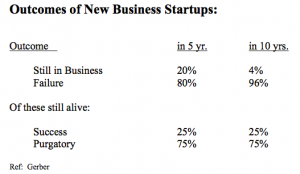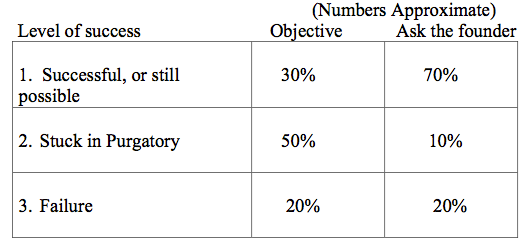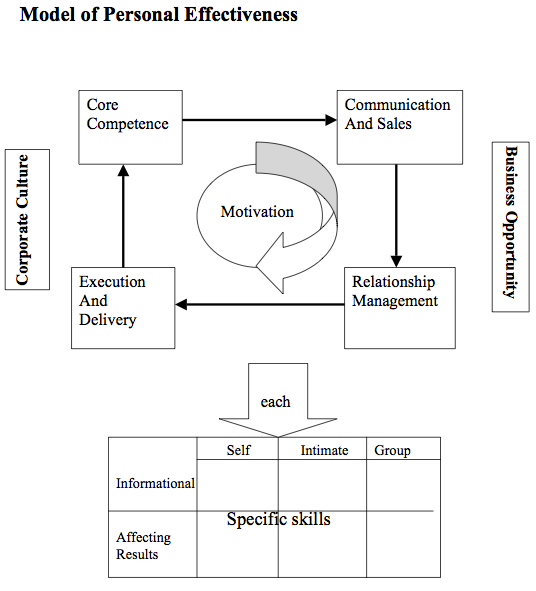1. The “Big Picture” of What We Will Cover![]()
2. Objectives of the Course
3. What You Need to Succeed
4. What Makes an Opportunity
5. Outcomes of New Businesses
6. Fatal Flaws
7. The Cornerstones of Competence
8. A Model of Personal Effectiveness
9. Rules
1.The Big Picture of What We Will Cover:
In the universe of the things you need to know, there are
• Fundamentals
• What you can easily learn elsewhere
• What you learn in the school of Hard Knocks
Most important learning comes from struggle
• It is expensive, and possibly fatal
• Failure is common, and a great teacher
What we will address:
• Standard stuff that kills or cripples most projects
• Going from nothing to something (most difficult)
• Τhe Intrepreneur and the Entrepreneur
• The “everything else”, especially people issues
What we will NOT address:
• What you can learn at Harvard (or Sloan)
• Fundamentals (like accounting)
Most projects fail from a fatal flaw that was obvious from the start
• Idea
• Business Plan
• Market or customers
• People issues – the usual killers
Rule: “Most businesses and projects fail from a fatal flaw. This fatal flaw is usually ‘people issues’ ”.
Rule: “If you are emotionally involved, you can’t see”
2. Objectives of this Course:
1. Where are we going?
a. Learn the “road map” for starting or running a business or large project
b. Learn the skills and behaviors needed
2. What is it like when we get there?
a. Learn where you are strong, and where you are weak. Develop your own checklist.
3. What is my role?
a. Participate, especially in the role -plays
b. Do the reading.
c. Do the exercises. Much of the work will be “outside of your comfort zone”.
4. What is in it for me?
a. Develop new skills. Learn how do be more effective
b. Knowledge of how to proceed with a business idea
c. Confidence that you can do it, (or know you can’t)
d. Knowledge about some of the normal ways to screw up
Rule: “For every project, you must be able to answer these four questions for your team members”.
3. What you need to succeed in any Venture (or win a war, take a bike trip, etc)
1. A personal goal
2. An opportunity
3. A road map (i.e. Knowledge of how to do it)
4. A skill set to succeed (Skills to do the job & No baggage to get in the way)
5. Resources to support your journey
Rules:
• “If you don’t know where you are going, you won’t get there”
• “(Readiness, Practice, Strength) + Opportunity = Win”
• “Develop your knowledge, skills and resources when you don’t need them. When you do need them, it is too late”.
4. What makes an Opportunity for a Technology based business:
1. New technology. A true invention or major leap on the existing practices
2. New market for existing technology.
3. Change in the environment, i.e. new regulations or laws
4. Others
• “Never underestimate the tendency for people to resist change.”
• Most effort in the “New x New” space is wasted. It is, however, alluring. Be careful of being trapped in this space
Rule: “The normal resting place for most startups is PURGATORY”
• How does the success rate differ for initiatives inside a large corporation?
• What is the success rate for internal projects in your group?
• What does Purgatory look like inside a large organization?
5. Survey of “MIT originated, Technology- based, New Business Startups”:
100 companies were surveyed, 2 ways, at 5 years after startup.
1. Success by objective measures: i.e. did they meet the plan that the investors signed up for
2. “Ask the founder”
Grouped roughly into 3 categories;
1. Successful, or “still have a chance” to be successful
2. Stuck in purgatory
3. Failure
• There was Little Correlation between the 2 “failure” groups.
• In fact, the founders who failed by objective measures often looked at themselves as successful !
• The primary measure of success for a founder was “I started a company”.
6.Fatal Flaws
“All successful families (businesses) are the same, all unsuccessful families (businesses) are unhappy in their own way”
(ref:Tolstoy, “Anna Karenina”)
Paradox: If you ask a successful entrepreneur “why” he was successful, he usually doesn’t know. (However, this will not usually keep him from having an opinion)
A venture can fail if ANY of a myriad of factors are not correct. We call these “fatal flaws”. You can understand what these factors are best, by studying the failures of a large number of businesses
These “Fatal Flaws” fall into 3 groups:
1. Business issues:
a. Does the team understand the process of building a business
b. Does the venture meet the test of being in the intersection of
i. Team (Especially the CEO or “Driver”)
ii. Resources (e.g. Money)
iii. Market Need (This has to be a large need = Pain!)
2. Personal issues
a. Do the team members, and especially the CEO (driver), have the personal skills and understanding to Make-it-happen
3. Organizational issues
a. Is the Corporate culture aligned with the venture, or at odds with the venture.
b. Is the teams cultural experience aligned with the venture, or can they act outside of their “roots”
We use the concept of “fatal flaws” to develop much of this course.
7.The Cornerstones of Competence:
1. Core Competence
a. This is what you do better than anyone else; (or at least as well as any nearby competitors)
b. This is often the “Trade”, which you learn in school
2. Communication
a. You have to be able to SELL your competence
b. You must convince someone to give you the right to practice your trade
3. Relationships
a. You must have someone to SELL TO, who wants, and is willing to accept, the result of your trade (your product)
b. These are BOTH external relationships (customers), AND internal relationships (your boss, your government). The external customers accept your product, and the internal customers allow you to practice.
4. Delivery
a. You must demonstrate the ability to deliver your product to the CUSTOMERS’ expectations. (timing, cost, quality, communication, etc).
b. Failure to deliver to the CUTOMERS” EXPECTATIONS, destroys the TRUST that the customer had in you. You may lose the right to practice your trade with that customer in the future.
5. Motivation
a. Motivation is what drives you around the competence process. It drives you to expand your core competence, and to sell and deliver this new competence
b. Lack of motivation can happen at any time, for a number of reasons, and is probably the single greatest factor in determining a team or individual’s success.
8.These skills exist in the context of a specific role that you are trying to fulfill.
9. Rules: Introduction and Overview
• Most businesses fail from a FATAL FLAW, which is evident to those not emotionally involved in the business.
• If you don’t know where you are going, you won’t get there.
• Fake it ‘til you make it.
• The Normal resting-place for most startups is Purgatory.
• Never underestimate the tendency of people to resist change.
• Cornerstones of Competence:
o Core competence
o Sales
o Relationships
o Delivery
o Motivation
• 3 groups of Fatal Flaws:
o Business issues (the world you are competing in)
o Organizational issues (your tribe)
o Personal effectiveness issues (your skills)
• All successful ventures are the same, all unsuccessful ones are different. Know the potential fatal flaws of your world.





